

Lex Barker (1919-1973) was born Alexander Crichlow Barker, Jr. in Rye, New York on May 8, 1919. He was a direct descendant of the founder of Rhode Island, Roger Williams, and of Sir Henry Crichlow, historical governor-general of Barbados. Barker excelled in football and track at Fessenden School and the prestigious Phillips-Exeter Academy. Lex attended Princeton University but left to pursue acting in summer stock which led him to Broadway. His education and acting were put on hold with America's entry into World War II when he enlisted as a buck private in the US Army. At the time of his discharge in 1945 he had risen to the rank of major and had served honourably in North Africa and Italy where he had been badly wounded.After the war he was signed by 20th Century Fox and then by Warner but he was too tall for supporting parts and too unknown for leads. As a result he appeared in a series of bit parts. He made his screen debut in Lewis Seilerís Doll Face, starring Vivian Blaine as a burlesque dancer, in a story written by Gypsy Rose Lee. Other small parts followed in numerous outstanding films: The Farmerís Daughter (1947 Best Actress Academy Award for Loretta Young), and Crossfire (Edward Dmytrykís 1947 milestone film noir), and in the Cary Grant comedy classic Mr. Blandings Builds His Dream House. His big break came when Lex, a six-foot, four-inch athlete with stunning good looks, was picked from a crowd of several hundred aspiring Tarzans by producer Sol Lesser. Edgar Rice Burroughs commented that Lex perfectly suited his original concept of a savage jungle character who was also an English blueblood. Between 1949 and 1953 he appeared in a total of five Tarzan films for RKO: Tarzan's Magic Fountain, Tarzan and the Slave Girl, Tarzan's Peril, Tarzan's Savage Fury, and Tarzan and the She-Devil.
His first jungle adventure was Tarzanís Magic Fountain (1949). Lexís jungle lord came closer than Weissmullerís to the original Edgar Rice Burroughs concept. Both press and audiences reacted positively and the film was a hit. Tarzan and the Slave Girl (1950), and Tarzanís Peril (1951), followed and helped sustain the popularity of the series. Interestingly, Tarzanís Peril was the first Tarzan film that was partly shot in Africa and not relying on African footage taken from other films (i.e. Trader Horn).
Exploiting Tarzanís continuing popularity, Sol Lesser continued to produce one Tarzan film per year. Tarzanís Savage Fury (1952) was another commercial success but there was increasing strain on the Barker/Lesser relationship. Lex was determined to put his own stamp on the Tarzan character and break from the Weissmuller mold. His vision of Tarzan was one closer to that of the intelligent English lord created by Burroughs. He also feared that he would become typecast as Tarzan and that he would never be given a chance to expand into other acting roles. This fear of typecasting even led him to turn down an offer to play the man of steel in the Superman television series. Finally, he was given the lead in Battles of Chief Pontiac - a film taking an intelligent view of American Indians - but it was not a box office success.
Tarzan and the She-Devil (1953), although another success, saw the amount of Barker dialogue cut in half -- a result of his constant arguing about his acting ambitions with producer Sol Lesser. This would be Barker's last Tarzan film, despite its success and its intriguing supporting cast: Raymond Burr (later Perry Mason) played the villain and 17-year-old Monique Van Vooren made her American film debut.
Barker now decided to sign only for one-film deals and Lesser signed Gordon Scott to star in Tarzan's Hidden Jungle (1955). Following the end of the Tarzan series, Barker made 16 films, mostly westerns, before major roles in Hollywood films dried up. With his career in trouble, he left Hollywood for Europe to star in "Kraut Westerns," a career move that pioneered Clint Eastwood's successful "spaghetti Westerns." His role in Fellini's La Dolce Vita in 1959 was a major career boost and, almost overnight, Lex became a European box office sensation (he was fluent in German, French, Spanish, and Italian). He then became better known in Germany than in the U.S. because of his role as "Old Shatterhand," "Kara Ben Nemsi" and "Dr. Karl Sternau" in 12 movies based on books written by Karl May, who is a very popular author for adventure literature in Germany. He won Germany's Bambi Award as Best Foreign Actor of 1966 and went on to make more than 70 films all over the world. His last two films, A Place Called Glory (1965) and Woman Times Seven (1967), were European productions.
By the 1970s, Lex had retired to his Costa Brava home on Spainís Mediterranean coast but was anxious to return to work in Hollywood. His Hollywood comeback involved TV guest appearances, including The FBI and It Takes A Thief with plans for his own series and film projects. This promising return to America came to a sudden end, however, when Lex died of a heart attack on Lexington Avenune in New York City, on May 11, 1973. He was only 54 years old.
Lex was married five times and had two sons and a daughter. His wives included American actresses Arlene Dahl and Lana Turner, and Swiss actress Irene Labhardt.

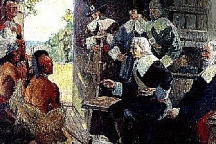













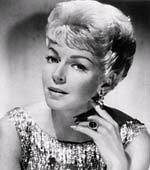





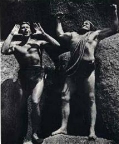



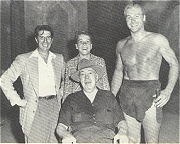
3-D TRADING CARDS ~ Part II
Scenes 16-30
Copyright T.C.G Ptd. in
U.S.A.
Courtesy Sol Lesser Productions,
Inc.
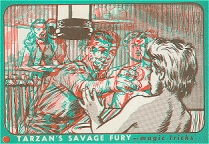 |
|
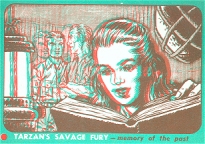 |
|
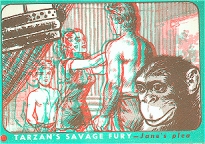 |
|
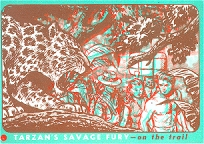 |
|
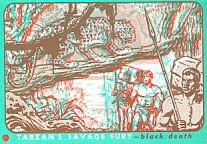 |
|
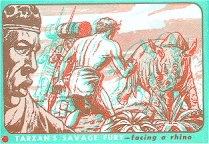 |
|
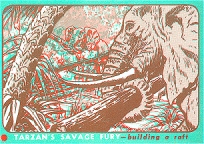 |
|
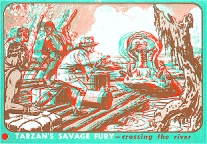 |
|
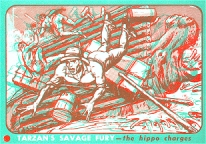 |
|
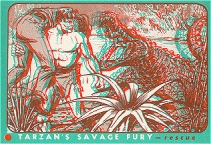 |
|
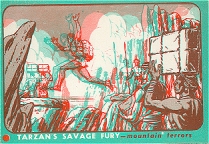 |
|
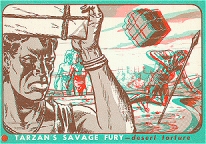 |
|
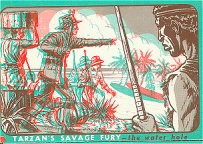 |
|
 |
|
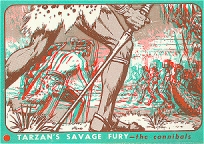 |
|
| 16. The Juju man is priest and doctor with great power
and responsibility. If he fails to prevent drought or disease, he may pay
with his life.
17. Some tribes jealously guard their hunting grounds. The stranger is never welcome and does well to avoid these places as he would a plague. 18. In parts of Africa there are no water holes for hundreds of miles and no animal life, only sandy wastes and dark canyons strewn with bones. 19. The African native knows, understands and sometimes worships animals. Here several live snakes are used by a dancer to help tell a story. 20. In Central and Southern Africa, the native never knows when he may become the victim of an elephant stampede. Entire villages are flattened. 21. The fearful grass fire is the scourge of the plains and dry forest. Animal and man, friend and foe, flee the great destroyer side by side. 22. Hiding in the trail grass, the python whips its coils about its victim and squeezes. For its greatest effort, it must grasp something with its tail. 23. The lumbering hippopotamus is a fast swimmer and a savage fighter when aroused. Its great jaws can make kindling wood of even a big canoe. 24. Many of the water holes of Africa dry up completely. Then the tribes are in desperate trouble, for few can survive the withering African sun. 25. The leopard is fast and tricky and feared by beast and tribesman alike. It attacks without warning, often leaping form a rock or tree branch. 26. The tusk of the elephant is sought by both native and trader. It may weigh as much as a heavyweight prizefighter and be six feet long. 27. Cannibalism was practiced by many tribes, some with the belief that they inherited the strength and skill of the man who stayed for dinner. 28. The jungle man believes his ornaments not only help to camouflage him but endow him with the forest virtues of the beasts and birds. 29. Hideous and vicious as the alligator is, its tail is considered a great treat by the swamp hunters. He is lassoed and speared to death. 30. Some jungle dwellers so fear the great meat eaters, they build houses in the trees high above the ground where few creatures can reach them. |
|
Film Credits Lex Barker Tarzan Film Trivia Pt. I: 3-D Cards 1-15 Jungle Land 1-15 Posters and Locations |
Lex Barker Biography Lex Barker Photo Gallery Pt: II: 3-D Cards 16-30 Jungle Land 16-30 |
|
Pt III: 3-D Cards 31-45 Jungle Land 31-45 Lex Barker Filmography (IMDB) Lex Barker Filmography & Links (E-Online) Tarzan's Savage Fury gallery of Movie Stills |
Pt. IV: 3-D Cards 46-60 Jungle Land 46-60 Lex Barker Gallery of Comics Covers Lex Barker Tarzan Film Reference Links |
![]()
![]()
![]()
Volume
0581

BILL
HILLMAN
Visit
our thousands of other sites at:
BILL
& SUE-ON HILLMAN ECLECTIC STUDIO
ERB
Text, ERB Images and Tarzan® are ©Edgar Rice Burroughs, Inc.-
All Rights Reserved.
All
Original Work ©1996-2004 by Bill Hillman and/or Contributing Authors/Owners
No
part of this web site may be reproduced without permission from the respective
owners.